Strength
I don't just talk about strength, I designed it in and proofed it out. Our wind tunnel testing sets a lofty new standard for showing you that the MoonLights are strong in every direction. As you watch the wind test video or look over the results, keep in mind three things:1) Most backpacking tents are flattened by 15 to 20 mph winds (24 to 32 kph) and most people in those winds would swear it was blowing 30-40mph. TRUE! It's a rare person that doesn't mis-gauge wind speed by almost a factor of TWO. So the wind speed results we show are winds that are really kicking it.
2) Our results are are not the blow-down and smash flat windspeed. We give you the windspeed up to which they are solid and quiet. These tents really can take a beating.
3) We tested without guylines and in all directions so you can be sure that the tent itself – as you are likely to put it up – is what's strong, not some fancy guyline work that took an hour to install (and a hundred feet of extra cord and a half pound of extra stakes). Crazy idea - doing it this way also tells us which direction we might want to occasionally guy the tent out.
Here’s the wind tunnel test video:
It's fair to say that most 3-season tents these days have modest strength and, often, full net bodies; leading sensible campers to pitch them in protected hollows. I don’t know about you, but that’s not the deal I’m looking for when I go to the mountains. I want views. The MoonLights take an unusual approach to help: they have high strength and lots of windows. The MoonLights are the strong silent type. They can safely be pitched in the less protected areas where the views are and still have quiet and worry-free sleep. And if the sunset becomes glorious while you’re inside a MoonLight, you’ve got a fighting chance of knowing it so you can get out and take a look.
That’s the attitude, here’s the results: Our MoonLight 3 and 4 tents are calm and quiet in winds up to 30-35mph. That’s a Force 7 wind on the Beaufort scale*. They aren’t actually blown down until the winds hit Force 8. The
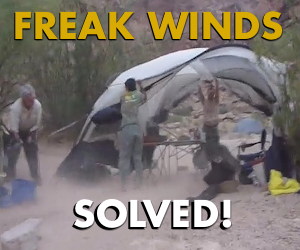
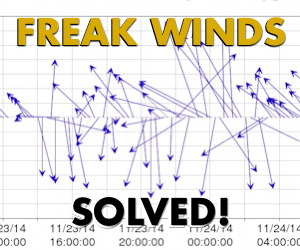
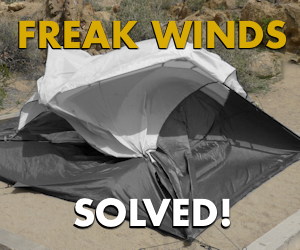
The MoonLight 2 is above average in strength but it will need guylines to bring it up to the 30-35mph strength that the bigger ones have. I know that may sound kind of bizarre. Bigger tents are almost always weaker than little ones. But I felt that the 2-person tent user wasn’t quite ready to buy a tent that was THAT much stronger. All the things that have been done with it: bigger, stronger and with fantastic features, have put it 11 to 13 ounces over the category leader. So we kept the 2-person model’s strength kind of reasonable rather than opting for even a little heavier.
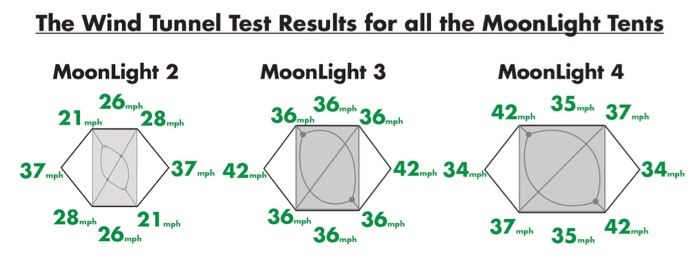
Sometimes it’s good to be reminded of exactly why having a strong tent and anchoring it well is a good idea. Here’s a little thing that happened on an otherwise sedate raft trip on the San Juan river in Utah:
The MoonLight 3 & 4 — ROCK SOLID in 30-35mph Winds From ANY Direction (35-40mph at 10,000ft)
First things first, 30-35mph is NOT the windspeed to BREAK the MoonLight 3 & 4s, it's the windspeed needed to BUDGE them. It's the speed up to which they're, well, rock solid. Winds that actually flatten them are in the 40+ to 50+ range depending on wind direction (at sea level). This contrasts sharply with the marketing approach of giving you the knockdown-breakdown windspeed (in just 1 direction). To my knowledge we are the first in the world to test a tent in all directions and show the public the results. Most tents have 1 or 2 strong directions. We tested all 4 unique strength directions and the results even amazed us. The MoonLights have remarkably uniform and high strength in every direction – proving the value of the eye-pole architecture, unitizing the frame with DAC Swivels, and using the PL 13.55mm pole.A very exposed camp on bare rock. It stormed and blew the night before, we enjoyed it, rolled over and slept.
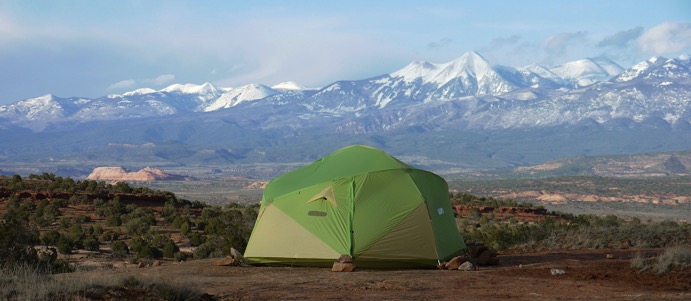
* Actually if you use the scale properly you have to peg the Beaufort number by the wind at 10m above ground (a standardized height for weather stations). Even in the most severely exposed locations this means that the wind at tent level is about 25% less. A 30-35mph at tent level is therefore a 40-53mph wind at 10m above ground which corresponds to a Force 8-9 on the Beaufort scale.
reference: http://en.wikipedia.org/wiki/Beaufort_scale
